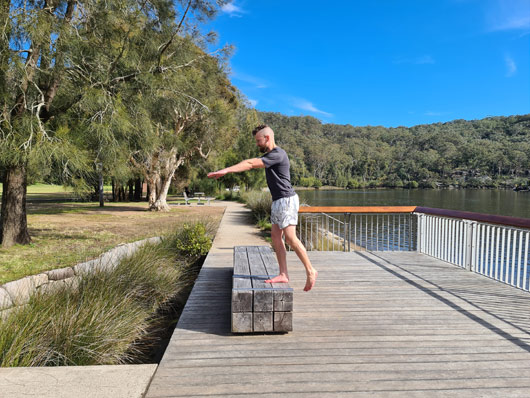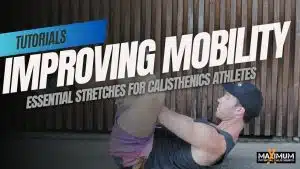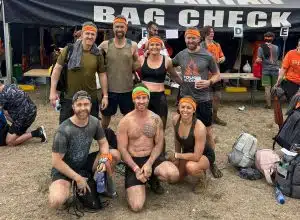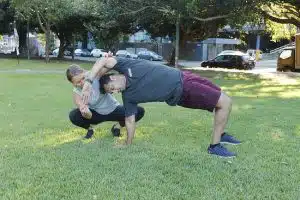All the essential information you need to know about doing a calisthenics leg workout.
BONUS: Check out the free calisthenics leg workout session available for download.
This workout has exercises for beginners to advanced levels.
Jump to the information you need:
- Can You Build Legs With Calisthenics?
- Why Do We Need Compound and Isolation Movement?
- How Often Should I Train Legs In Calisthenics?
- Is Push Pull Legs Good In Calisthenics?
- What Are The Benefits Of Doing Calisthenics Leg Exercises?
- How Can I Do A Calisthenics Leg Workout With No Equipment?
- What Are The Hardest Calisthenics Leg Exercises?
- How To Do A Calisthenics Leg Warm Up
- Calisthenics Leg Workout

Can You Build Legs With Calisthenics?
This means train at or close to failure (doing an exercise or progression that is difficult enough for you to reach failure).
Isolate to make sure that individual muscles are reaching failure.
Calisthenics is not known for isolation but there is a reason why bodybuilders isolate muscles.
Why Do We Need Compound and Isolation Movement?
Failure in an exercise or reaching close to failure is the key to building muscle.
If you’re doing a compound movement (multiple muscles are involved) it won’t be all of those muscles that reach failure – it will typically just be one.
This means that some of the other muscles that you believe you are working in that movement are not reaching failure and will therefore not maximise their growth.
Muscles such as the hamstrings may be neglected during these big compound movements.
What’s the answer? Include both compound and isolation leg exercises in your workout.
Jump to the workout below to see how to include both types of movement.
How Often Should I Train Legs In Calisthenics?
Beginners can do a leg session once a week.
If you already have well developed legs you are going to need to do 2-3 leg workouts per week.
Make sure you have a day’s rest in between leg workouts.

Is Push Pull Legs Good In Calisthenics?
- Push (triceps, shoulders and chest) workout on a Monday
- Pull (biceps and back) workout on Tuesday (or Wednesday if you need a rest day)
- Legs the following day
- Repeat
This is good for building up those leg sessions and getting strong legs.
What Are The Benefits Of Doing Calisthenics Leg Exercises?
- Injury prevention – for example weak glutes which can contribute to back and knee problems
- Healthy joints – by strengthening the muscles around the knee, ankle and hip joint as well as the muscles in the feet for stability, the joints are protected and it strengthens the connective tissue around the joints
- Increased stability – because calisthenics involves a lot of single leg work it forces the stabilisation muscles to activate and strengthen
- Aesthetics – lean and toned looking legs and a more balanced look as you aren’t just training your upper body
How Can I Do A Calisthenics Leg Workout With No Equipment?
- Pistol squat progressions – choose the exercise based on your level.
- Body weight quad extensions. Note this should only be done if you are also working your hamstrings.
- Single leg straight bridge work the hamstrings and are a beginner-intermediate progression.
- Lunge progressions or step downs (stairs or step required)
What Are The Hardest Calisthenics Leg Exercises?
The turbo shrimp squat is probably one of the hardest calisthenics leg exercises, likewise a Nordic hamstring curl all the way down to the ground takes serious hamstring strength.
Here’s our student Henry performing a turbo shrimp squat.
How To Do A Calisthenics Leg Warm Up
Here is an example of a calisthenics leg warm up routine you can do to get your body prepared for your workout.
Inch Worm Crawl x 10 Reps
Bend your knees and put your hands on the floor, walk your hands out in front of you then follow with your feet and repeat.
World's Greatest Stretch x 10 Reps on Each Side
Kneel down, then place one leg out in front of you with your foot flat on the ground and your hands on the floor (or on your mat) around shoulder width apart (the arm closest to the front foot should be on the outside of the foot).
Move the other leg out behind you with toes on the floor.
Feel the stretch in your legs and hip flexors.
Use the opposite arm to the leg that is out in front and lean forward to place the forearm flat on the ground (or as close as you can), then sweep the arm up towards the sky, with your gaze following it (looking away from the body), repeat.
Follow a smooth motion and only go as far as feels comfortable.
Don’t rush this movement.
Pike Squats x 10 Reps
Stand with your legs a little wider than hip distance apart.
Bend the knees, reach down and grab the tips of your toes (alternatively hold your ankles).
Bend the knees so you go into a squat (as deep as feels comfortable), then keeping hold of your feet (or ankles) start to straighten the legs, then repeat.
Calisthenics Leg Workout
All exercises below are aimed at intermediate and above.
To get your own workout cutomised to your level (beginner, intermediate or advanced), download your free Calisthenics Leg Workout pdf.
We will split this workout into compound movements and isolation. Start and finish compound movements before moving to isolation.
Compound Movements
Aim for 5 reps for 2-5 sets of the following exercises, depending on how much time you have.
1. Pistol Squat
The primary muscles this works are your glutes and quads.
You also use stabilisation muscles including those that support the ankle and hip.
Take a look at the pistol squat tutorial for detail on how to progress this exercise.
2. Dragon Pistol Squat
Again the glutes and quads are worked.
However this one requires high levels of flexibility.
For a detailed breakdown see this dragon pistol squat tutorial.
3. Turbo Shrimp Squat
This is a glute dominant exercise which also works the quads.
This exercise is unique in that it has the ability to be a beginner exercise all the way to advanced as you can elevate one leg and dip down with the other leg.
Turbo shrimp squat, is basically a shrimp squat on a raised object, making it harder as you have a bigger range of movement.
Isolation Movements
Aim for 6-10 reps for 3-5 sets.
Measuring
Firstly it is very important that you measure the progress of your isolation exercises.
In weight lifting you do this by measuring the weight that you are lifting.
In calisthenics, we can measure distance, using a tape measure.
1. Body Weight Quad Extension (Quads)
- Find a wall, kneel down facing away from the wall, with the top of your feet flat against the ground.
- Start with a 60-70cm distance from the wall, measured from the front of the knee.
- Keep a straight line between your knees, hips and shoulders throughout the movement.
- Lean back until the back of your head touches the wall.
- Use your quads to push back to the start position.
- Keep your glutes and abs engaged to help keep the straight line, you should feel the burn in your quads.
Note: Any knee pain at all, stop. Reducing distance from the wall may help. Use a small mat or towel to cushion the knees.
How to progress/ regress:
If your reps drop below 6, move closer to the wall.
If 10 reps is manageable with good form then move further away from the wall – don’t forget to measure and record the distance.
The ultimate goal is to get all the way down to the floor, without needing the wall. This requires a lot of strength as you can see demonstrated here by our student, Laura:
2. Nordic Hip Hinge (Hamstrings)
To perform this exercise you either need a partner to hold your ankles or something to hook your feet under such as a low bar, bottom of a fence or gate etc.
Measuring: place a mat or towel approx 60-80 cm in front of your body measured from your ankles.
- Kneel down away from the low bar and hook your feet under it.
Alternatively ask your partner to hold your ankles and push down firmly to support your weight. - Bend forward at the hips until your head taps the mat
- Pull yourself back up using your hamstrings, keeping your back straight throughout. Squeeze your glutes.
To increase or decrease difficulty, place the mat further away or bring it closer (easier).
3. Single Leg Glute Bridge (Glutes)
Start position: Lie on your back one leg bent with the foot flat on the ground, the other one in the air.
Squeeze your glutes as hard as you can and lift your hips up, hold for a second and slowly lower back to the start position.
To make it harder, elevate your shoulders which puts more weight through the legs. Or elevate the foot to increase the range of motion, or both.
Calisthenics Leg Workout Download
- Free workout download
- Exercises for beginners, intermediate and advanced levels
- Plus a printable workout template + weekly workout planner so you can be organised for the week ahead!



